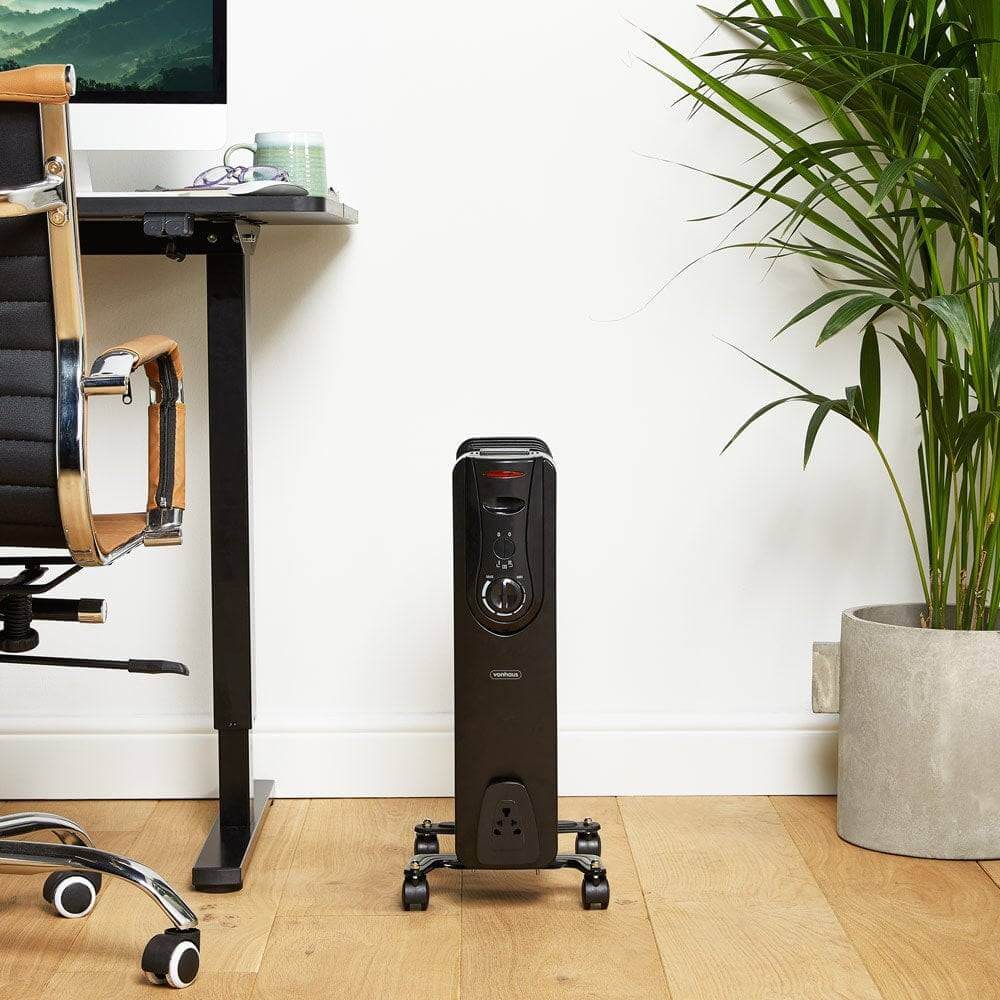How much does it cost to run an oil-filled radiator?
Curious about how much it costs to run an oil-filled radiator? You’re in the right place!
In this guide, we’ll break down everything from wattage and room size to electricity rates, so you can get a clear picture of the expenses involved.
Ready to crunch some numbers? Just kidding, we've done them for you ; )
Let’s get started.
What is an oil-filled radiator?


First, a quick refresher.
An oil-filled radiator is an electric heater that uses thermal oil to provide steady, efficient warmth.
These radiators are incredibly popular due to their ability to retain heat, meaning they stay warm longer and keep your space cosy without constantly consuming electricity.
Want to dive deeper into how they work?
Factors affecting oil radiator running costs
Now, let’s asses the factors that determine how much you’ll spend on running an oil-filled radiator.
Radiator size and wattage
The size and wattage of your radiator play a big role in running costs.
Here’s a quick overview:
| Radiator size | Wattage | Room size |
| Small | Up to 600W | Ideal for small rooms or spaces. |
| Medium | 600W - 1500W | Perfect for medium-sized rooms. |
| Large | 1500W - 2000W | Great for larger living areas. |
| Extra Large | 2000W+ | Best for open-plan spaces or large rooms. |
Room size and insulation
The size of the room and its insulation quality will also impact costs.
Well-insulated rooms retain heat better, making your radiator more efficient.
In contrast, larger rooms or spaces with poor insulation will require more energy to maintain a comfortable temperature.
Usage time
How long you use the radiator each day is another crucial factor.
Running your radiator for a few hours in the evening will cost less than keeping it on all day.
Electricity rates
Finally, the cost of electricity in your area will directly affect your running costs.
Check your electricity bill or provider’s website to find your current rate per kilowatt-hour (kWh).
Example cost calculations
Let's break down the running costs for different room sizes using the 2024 average electricity rates provided by Ofgem.
· 24.5p per kilowatt hour (kWh)
· 60.1p daily standing charge
Small room
| Radiator Wattage | 600W |
| Usage | 4 hours/day |
| Energy Consumption (600W * 4 hours) | 2.4kWh/day |
| Electricity Cost | 58.8p/day |
| Total Daily Cost (58.8p + 60.1p) | Approx. £1.19/day |
Medium room
| Radiator Wattage | 1500W |
| Usage | 4 hours/day |
| Energy Consumption (1500W * 4 hours) | 6kWh/day |
| Electricity Cost (6 kWh * 24.5p/kWh) | £1.47/day |
| Total Daily Cost (147p + 60.1p) | Approx. £2.07/day |
Large room
| Radiator Wattage | 2000W |
| Usage | 4 hours/day |
| Energy Consumption (2000W * 4 hours) | 8 kWh/day |
|
Electricity Cost (8 kWh * 24.5p/kWh) |
£1.96/day |
| Total Daily Cost (196p + 60.1p) | Approx. £2.56/day |
By using these calculations, you can see how different factors, such as radiator size and electricity rates, impact the cost of running an oil-filled radiator.
Remember to consider your own electricity rate and usage patterns to get the most accurate estimate for your specific situation.
Want more tips on managing your heating costs? Head over to our guide on finding the most energy-efficient heaters and start saving today!
Tips to reduce oil radiator running costs


Looking to keep your heating costs down? Here are four handy tips that can help you save money while keeping your home warm and cosy.
1. Use a Timer
One of the easiest ways to reduce heating costs is by using a timer.
Why it helps
Reduce Unnecessary Usage
A timer ensures that your oil-filled radiator only runs when you need it. No more wasting energy heating an empty room.
Optimise Heating Schedule
Program the radiator to turn on just before you wake up or get home, so you walk into a warm room without having it run all day.
Consistency
Regular on/off schedules help maintain a comfortable temperature without fluctuations, which can be more energy efficient.
2. Improve Insulation
Proper insulation can make a massive difference in your heating costs.
Why it helps
Retain Heat
Good insulation keeps the heat inside your room, reducing the amount of energy needed to maintain a cosy temperature.
Lower Running Time
With better insulation, your oil-filled radiator doesn’t have to work as hard or as long, saving you money on electricity.
Drafts Be Gone
Sealing windows, doors, and any gaps prevents cold air from entering and warm air from escaping.
Tips for Better Insulation
Windows: Use double glazing or thermal curtains.
Doors: Install draft excluders.
Walls: Consider adding or improving wall insulation.
3. Regular Maintenance
Keeping your oil-filled radiator in top shape ensures it runs efficiently and effectively.
Why it helps
Optimal Performance
Regular maintenance, like cleaning the radiator and checking for any issues, ensures it operates at its best.
Preventive Care
Addressing minor problems before they become major ones can extend the lifespan of your radiator and maintain its efficiency.
Safe Operation
Regular checks can also prevent potential safety issues, like overheating or malfunctions.
Maintenance Tips
Dust Regularly
Keep the surface and fins of the radiator free from dust and debris.
Check for Leaks
Ensure there are no oil leaks or signs of damage.
Professional Servicing
Consider periodic professional servicing to keep your radiator in peak condition.
4. Energy-Efficient Heaters
If your current oil-filled radiator is old or not performing well, it might be time to consider an upgrade.
Remember, all VonHaus products include a free 2-year warranty, giving you total peace of mind.
Why it helps
Cutting Edge Tech
Newer models often come with advanced features like better insulation, more efficient heating elements, and programmable settings.
Energy Savings
Energy-efficient models consume less power while providing the same or better heating performance.
Eco-Friendly
Reducing energy consumption not only saves you money but also reduces your carbon footprint.
Choosing an Energy-Efficient Heater
Look for Energy Ratings
Check for models with high energy efficiency ratings.
Advanced Features
Consider features like programmable timers, thermostats, and eco modes.
Read Reviews
See what other users say about the efficiency and performance of different models.
So, there you have it! Running an oil-filled radiator doesn’t have to break the bank.
By understanding the factors that influence costs and following our tips, you can keep your home cosy and your energy bills manageable.
Sounds like a win-win to us!
Ready to find the perfect oil-filled radiator for your needs?


